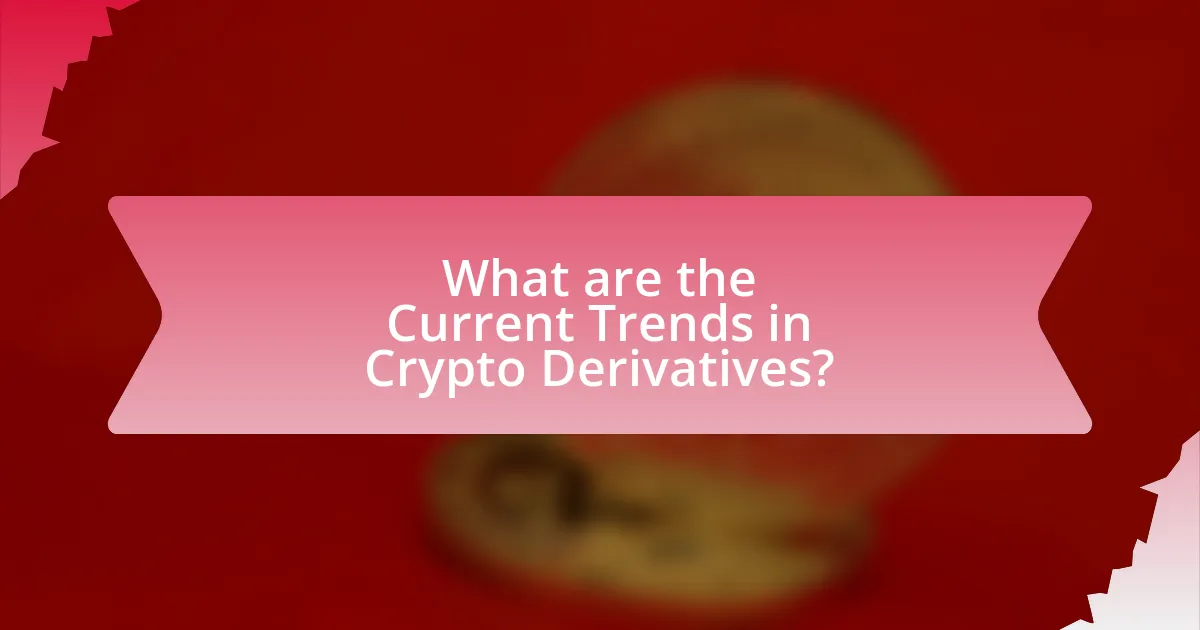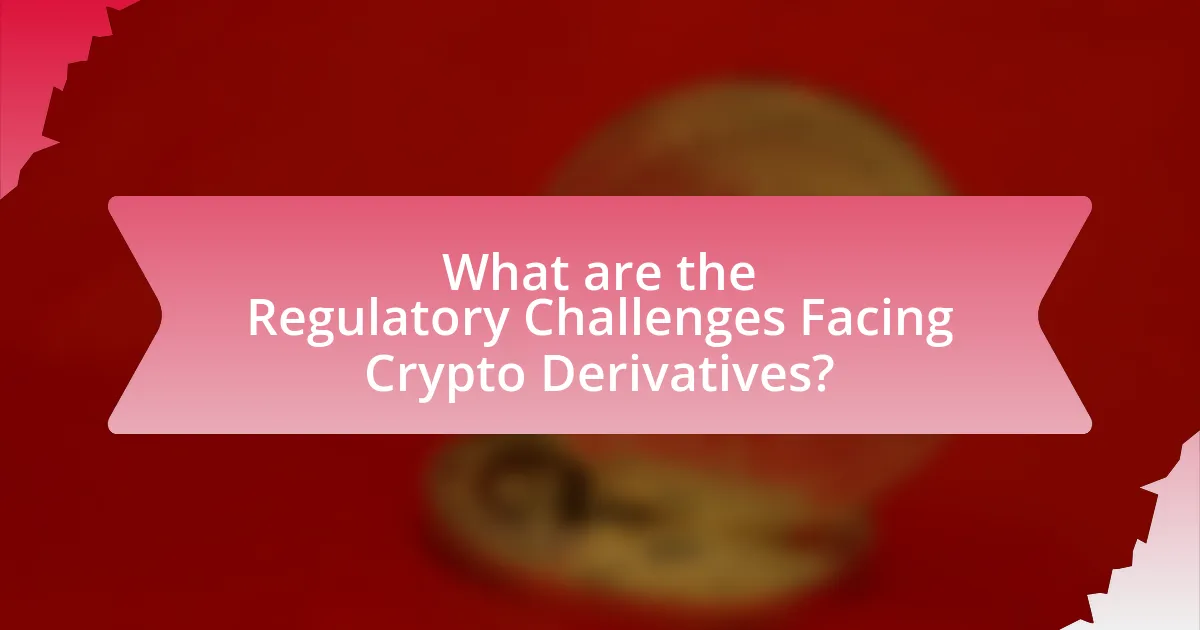Crypto derivatives are financial contracts whose value is based on underlying cryptocurrencies, such as Bitcoin and Ethereum, allowing traders to speculate on price movements, hedge against volatility, and gain exposure without direct ownership. The article explores the functioning of crypto derivatives in financial markets, their types, and their differences from traditional derivatives. It also examines the role of crypto derivatives in risk management, current market trends, regulatory challenges, and the impact of technological advancements. Additionally, the article discusses the future prospects for crypto derivatives, including potential regulatory developments and strategies for investors to navigate this evolving landscape.

What are Crypto Derivatives and Why are They Important?
Crypto derivatives are financial contracts whose value is derived from the price of underlying cryptocurrencies, such as Bitcoin or Ethereum. They are important because they enable traders to speculate on price movements, hedge against market volatility, and gain exposure to cryptocurrencies without directly owning them. The global crypto derivatives market has seen significant growth, with trading volumes reaching over $1 trillion in 2021, highlighting their increasing relevance in the financial ecosystem.
How do Crypto Derivatives function in the financial market?
Crypto derivatives function in the financial market by allowing traders to speculate on the future price movements of cryptocurrencies without owning the underlying assets. These financial instruments, such as futures and options, enable participants to hedge against price volatility or leverage their positions for potential profit. For instance, the Chicago Mercantile Exchange (CME) introduced Bitcoin futures in December 2017, which provided institutional investors with a regulated platform to trade Bitcoin derivatives, thereby increasing market liquidity and price discovery. This mechanism allows traders to manage risk and capitalize on market trends, contributing to the overall efficiency and stability of the cryptocurrency market.
What types of Crypto Derivatives are commonly traded?
Commonly traded crypto derivatives include futures, options, and perpetual swaps. Futures contracts obligate the buyer to purchase, and the seller to sell, an asset at a predetermined price at a specified future date. Options provide the buyer the right, but not the obligation, to buy or sell an asset at a set price before a specified expiration date. Perpetual swaps are similar to futures but do not have an expiration date, allowing traders to hold positions indefinitely. These derivatives are widely used for hedging and speculation in the cryptocurrency market, reflecting their growing importance in the financial landscape.
How do Crypto Derivatives differ from traditional derivatives?
Crypto derivatives differ from traditional derivatives primarily in their underlying assets and market structure. Traditional derivatives are based on established assets like stocks, bonds, or commodities, while crypto derivatives are linked to cryptocurrencies such as Bitcoin or Ethereum. Additionally, the regulatory environment for crypto derivatives is less defined, leading to increased volatility and risk compared to traditional derivatives, which operate under stricter regulations and oversight. The trading hours for crypto derivatives are also continuous, unlike traditional derivatives that are typically limited to specific market hours. This difference in trading dynamics contributes to the unique risk profiles and liquidity characteristics of crypto derivatives.
What role do Crypto Derivatives play in risk management?
Crypto derivatives play a crucial role in risk management by allowing investors to hedge against price volatility in the cryptocurrency market. These financial instruments, such as futures and options, enable traders to lock in prices or speculate on future price movements, thereby mitigating potential losses. For instance, a study by the Bank for International Settlements in 2021 highlighted that derivatives can reduce exposure to market fluctuations, providing a safety net for investors during periods of high volatility. This functionality is particularly important in the crypto space, where price swings can be extreme, thus reinforcing the significance of crypto derivatives in effective risk management strategies.
How can investors use Crypto Derivatives to hedge against volatility?
Investors can use crypto derivatives, such as futures and options, to hedge against volatility by locking in prices for future transactions. This strategy allows them to mitigate potential losses from price fluctuations in the underlying cryptocurrency market. For instance, if an investor holds Bitcoin and anticipates a price drop, they can sell Bitcoin futures contracts to offset potential losses. Historical data shows that during periods of high volatility, such as the 2017 Bitcoin price surge, the use of derivatives increased significantly, demonstrating their effectiveness in risk management. By employing these financial instruments, investors can create a more stable investment environment despite the inherent volatility of cryptocurrencies.
What are the potential risks associated with Crypto Derivatives?
The potential risks associated with crypto derivatives include high volatility, lack of regulation, counterparty risk, and market manipulation. High volatility in the underlying cryptocurrencies can lead to significant losses for traders, as prices can fluctuate dramatically in short periods. The lack of regulation in many jurisdictions means that investors may not have the same protections as they would in traditional financial markets, increasing the risk of fraud or market abuse. Counterparty risk arises when the entity facilitating the trade fails to fulfill its obligations, which can lead to financial losses. Additionally, market manipulation is a concern, as the relatively low liquidity in some crypto markets can allow for price manipulation tactics, further endangering investors. These risks highlight the need for caution and thorough understanding before engaging in crypto derivatives trading.

What are the Current Trends in Crypto Derivatives?
Current trends in crypto derivatives include increased institutional participation, the rise of decentralized finance (DeFi) derivatives, and the growing popularity of options trading. Institutional investors are increasingly entering the crypto derivatives market, as evidenced by a report from Fidelity Digital Assets indicating that 70% of institutional investors view digital assets as a viable investment. DeFi derivatives platforms, such as Synthetix and dYdX, are gaining traction, allowing users to trade synthetic assets without intermediaries. Additionally, options trading volume has surged, with the total open interest in Bitcoin options reaching over $10 billion in 2023, reflecting a shift towards more sophisticated trading strategies. These trends highlight the evolving landscape of crypto derivatives and their integration into mainstream finance.
How is the market for Crypto Derivatives evolving?
The market for crypto derivatives is rapidly evolving, characterized by increased trading volumes and the introduction of innovative products. In 2023, the global crypto derivatives market reached a valuation of approximately $1 trillion, reflecting a significant rise in institutional participation and retail interest. This growth is driven by the demand for hedging strategies and speculative trading, as investors seek to capitalize on the volatility of cryptocurrencies. Additionally, regulatory developments are shaping the landscape, with jurisdictions implementing clearer frameworks that enhance market integrity and investor protection. For instance, the European Union’s Markets in Crypto-Assets (MiCA) regulation aims to provide a comprehensive regulatory approach, fostering a safer trading environment.
What innovations are emerging in the Crypto Derivatives space?
Emerging innovations in the crypto derivatives space include decentralized finance (DeFi) protocols, which enable users to trade derivatives without intermediaries, and the introduction of synthetic assets that mimic the value of real-world assets. These innovations enhance liquidity and accessibility in the market. Additionally, the development of automated market makers (AMMs) allows for more efficient pricing and trading of derivatives. According to a report by the Bank for International Settlements, the growth of these technologies is reshaping traditional financial systems and increasing participation in crypto markets.
How are institutional investors influencing the Crypto Derivatives market?
Institutional investors are significantly influencing the Crypto Derivatives market by increasing liquidity and driving the development of more sophisticated financial products. Their participation has led to a surge in trading volumes; for instance, in 2021, institutional trading accounted for over 60% of the total Bitcoin futures volume on major exchanges. This influx of capital has prompted exchanges to introduce new derivatives products, such as options and ETFs, catering to institutional needs. Furthermore, institutional involvement has encouraged regulatory bodies to establish clearer guidelines, enhancing market legitimacy and attracting more participants.
What are the implications of technological advancements on Crypto Derivatives?
Technological advancements significantly enhance the efficiency, accessibility, and security of crypto derivatives. Innovations such as blockchain technology enable real-time settlement and reduce counterparty risk, while smart contracts automate execution and compliance, streamlining processes. Additionally, advancements in data analytics and artificial intelligence improve market predictions and risk management, allowing traders to make informed decisions. For instance, the introduction of decentralized finance (DeFi) platforms has democratized access to derivatives trading, enabling a broader range of participants to engage in the market. These developments collectively contribute to a more robust and dynamic trading environment for crypto derivatives.
How does blockchain technology impact the trading of Crypto Derivatives?
Blockchain technology significantly enhances the trading of crypto derivatives by providing transparency, security, and efficiency. The decentralized nature of blockchain allows for real-time settlement of trades, reducing counterparty risk and the need for intermediaries. Additionally, smart contracts automate the execution of trades based on predefined conditions, which minimizes human error and increases trust among participants. According to a report by the World Economic Forum, blockchain could reduce operational costs in financial services by up to 30%, highlighting its potential to transform the trading landscape for crypto derivatives.
What role do smart contracts play in Crypto Derivatives transactions?
Smart contracts automate and enforce the terms of crypto derivatives transactions, ensuring that agreements are executed without the need for intermediaries. By utilizing blockchain technology, smart contracts provide transparency and security, allowing for real-time settlement and reducing counterparty risk. For instance, in a futures contract, the smart contract automatically executes the trade when predefined conditions are met, such as price thresholds, thereby minimizing the potential for disputes. This efficiency and reliability are crucial in the rapidly evolving landscape of crypto derivatives, where speed and accuracy are paramount for market participants.

What are the Regulatory Challenges Facing Crypto Derivatives?
Regulatory challenges facing crypto derivatives include the lack of a unified regulatory framework, which leads to inconsistencies across jurisdictions. Different countries have varying approaches to defining and regulating crypto derivatives, creating uncertainty for market participants. For instance, the U.S. Commodity Futures Trading Commission (CFTC) classifies certain crypto derivatives as commodities, while the European Securities and Markets Authority (ESMA) may categorize them differently under existing financial regulations. This divergence complicates compliance for firms operating internationally and can hinder innovation in the sector. Additionally, concerns regarding market manipulation, investor protection, and anti-money laundering (AML) compliance further complicate the regulatory landscape, as regulators seek to establish rules that address these issues without stifling growth.
How do different countries regulate Crypto Derivatives?
Different countries regulate crypto derivatives through a variety of frameworks that reflect their unique legal, economic, and technological contexts. For instance, the United States primarily regulates crypto derivatives under the Commodity Futures Trading Commission (CFTC), which classifies cryptocurrencies as commodities and oversees futures and options trading. In contrast, the European Union is developing a comprehensive regulatory framework known as the Markets in Crypto-Assets (MiCA) regulation, which aims to create a unified approach to crypto assets, including derivatives, across member states.
In Asia, countries like Japan have established a licensing system for crypto exchanges under the Financial Services Agency (FSA), which includes provisions for derivatives trading. Meanwhile, China has imposed strict bans on crypto derivatives trading, reflecting its broader stance against cryptocurrencies.
These regulatory approaches highlight the diverse strategies employed globally, with some nations embracing crypto derivatives as part of their financial systems while others impose restrictions or outright bans.
What are the key regulatory frameworks affecting Crypto Derivatives globally?
The key regulatory frameworks affecting crypto derivatives globally include the European Union’s Markets in Crypto-Assets Regulation (MiCA), the United States’ Commodity Futures Trading Commission (CFTC) regulations, and the Financial Conduct Authority (FCA) guidelines in the UK. MiCA aims to create a comprehensive regulatory framework for crypto assets, including derivatives, ensuring consumer protection and market integrity. The CFTC regulates derivatives markets in the U.S., classifying certain cryptocurrencies as commodities and overseeing futures and options trading. The FCA has implemented rules to govern crypto derivatives, focusing on investor protection and risk management. These frameworks are essential for establishing legal clarity and fostering responsible market practices in the rapidly evolving crypto derivatives landscape.
How do regulatory differences impact market participants?
Regulatory differences significantly impact market participants by creating varying compliance requirements and operational challenges across jurisdictions. For instance, in the United States, the Commodity Futures Trading Commission (CFTC) regulates derivatives, while in the European Union, the European Securities and Markets Authority (ESMA) oversees similar products, leading to discrepancies in reporting standards and capital requirements. These differences can result in increased costs for market participants who must navigate multiple regulatory frameworks, potentially limiting their ability to compete effectively. Additionally, regulatory uncertainty can deter investment and innovation in crypto derivatives, as firms may hesitate to enter markets with unclear or inconsistent rules.
What are the potential future regulatory developments for Crypto Derivatives?
Potential future regulatory developments for crypto derivatives include increased oversight from financial authorities, standardization of reporting requirements, and the establishment of clearer definitions for digital assets. Regulatory bodies like the U.S. Commodity Futures Trading Commission (CFTC) and the European Securities and Markets Authority (ESMA) are actively working on frameworks to address market integrity and investor protection. For instance, the CFTC has proposed rules to enhance transparency in derivatives markets, which could lead to mandatory registration for crypto derivatives exchanges. Additionally, the Financial Stability Board (FSB) has emphasized the need for a global regulatory approach to mitigate systemic risks associated with crypto derivatives, indicating that international cooperation will likely shape future regulations.
How might upcoming regulations shape the Crypto Derivatives landscape?
Upcoming regulations are likely to enhance the legitimacy and stability of the Crypto Derivatives landscape by imposing stricter compliance requirements on trading platforms and financial institutions. These regulations may include mandatory reporting standards, enhanced transparency measures, and consumer protection protocols, which can mitigate risks associated with market manipulation and fraud. For instance, the European Union’s Markets in Crypto-Assets (MiCA) regulation aims to create a comprehensive regulatory framework that addresses these issues, thereby fostering investor confidence and encouraging institutional participation in the crypto derivatives market. As a result, the implementation of such regulations could lead to increased market maturity and a more structured trading environment.
What are the implications of stricter regulations for market participants?
Stricter regulations for market participants in the crypto derivatives market lead to increased compliance costs and operational challenges. Market participants, including exchanges and traders, must invest in systems and processes to adhere to new regulatory requirements, which can reduce profit margins. For instance, a report by the Financial Stability Board in 2020 highlighted that enhanced regulatory frameworks could necessitate significant investments in technology and compliance personnel, impacting smaller firms disproportionately. Additionally, stricter regulations may limit the range of products offered, as firms become more cautious in their offerings to avoid regulatory scrutiny. This can lead to reduced market liquidity and innovation, as participants may withdraw from high-risk activities.

What are the Future Prospects for Crypto Derivatives?
The future prospects for crypto derivatives are promising, driven by increasing institutional interest and regulatory clarity. As of 2023, the global crypto derivatives market has seen significant growth, with trading volumes reaching over $1 trillion monthly, indicating robust demand. Regulatory developments, such as the European Union’s Markets in Crypto-Assets (MiCA) framework, aim to provide a structured environment for trading these instruments, enhancing investor confidence. Furthermore, the integration of traditional financial institutions into the crypto space is expected to lead to more sophisticated products, such as options and futures, catering to a wider range of investors. This evolution suggests that crypto derivatives will become a more integral part of the financial ecosystem, facilitating risk management and investment strategies.
How might the demand for Crypto Derivatives change in the coming years?
The demand for crypto derivatives is likely to increase significantly in the coming years due to growing institutional interest and the maturation of the cryptocurrency market. As more institutional investors enter the space, driven by the need for hedging and risk management tools, the utilization of derivatives such as futures and options will rise. According to a report by Fidelity Digital Assets, 80% of institutional investors surveyed expressed interest in investing in digital assets, indicating a strong potential for derivatives trading. Additionally, advancements in regulatory frameworks are expected to provide a clearer operational landscape, further encouraging participation in crypto derivatives markets.
What factors could drive the growth of Crypto Derivatives?
The growth of crypto derivatives could be driven by increased institutional adoption, regulatory clarity, and the demand for risk management tools. Institutional investors are increasingly entering the cryptocurrency market, as evidenced by a report from Fidelity Digital Assets indicating that 70% of institutional investors view digital assets as a viable investment. Regulatory clarity can enhance market confidence, as seen in jurisdictions like the European Union, which is working on comprehensive regulations for crypto assets. Additionally, the demand for risk management tools is rising, with a study by the Bank for International Settlements showing that derivatives can help mitigate volatility in the underlying asset markets. These factors collectively contribute to the anticipated growth of crypto derivatives.
How can market participants prepare for future trends in Crypto Derivatives?
Market participants can prepare for future trends in crypto derivatives by staying informed about regulatory developments and technological advancements. Continuous education on evolving regulations, such as the European Union’s Markets in Crypto-Assets Regulation (MiCA), which aims to create a comprehensive regulatory framework for crypto assets, is essential. Additionally, participants should leverage analytics tools to monitor market trends and sentiment, as evidenced by the increasing use of data analytics in trading strategies, which has shown to enhance decision-making efficiency. Engaging with industry forums and participating in discussions can also provide insights into emerging trends and best practices, ensuring that market participants remain competitive and compliant in a rapidly changing landscape.
What best practices should investors follow when engaging with Crypto Derivatives?
Investors engaging with crypto derivatives should prioritize risk management, thorough research, and regulatory compliance. Risk management involves setting clear stop-loss orders and position sizes to mitigate potential losses, as the volatility in crypto markets can lead to significant price swings. Conducting thorough research includes understanding the underlying assets, market trends, and the specific mechanics of the derivatives being traded, such as futures or options. Regulatory compliance is crucial, as adhering to local laws and regulations can prevent legal issues and ensure the legitimacy of trading activities. For instance, the Commodity Futures Trading Commission (CFTC) in the United States regulates derivatives, and staying informed about these regulations can help investors navigate the legal landscape effectively.
How can investors mitigate risks associated with Crypto Derivatives trading?
Investors can mitigate risks associated with Crypto Derivatives trading by employing strategies such as diversification, using stop-loss orders, and conducting thorough market analysis. Diversification reduces exposure to any single asset, thereby lowering potential losses; for instance, spreading investments across various cryptocurrencies can help balance risk. Utilizing stop-loss orders allows investors to automatically sell a derivative when it reaches a certain price, limiting potential losses in volatile markets. Additionally, conducting thorough market analysis, including understanding market trends and regulatory changes, equips investors with the knowledge to make informed decisions, thereby reducing the likelihood of significant financial setbacks.
What strategies can enhance the effectiveness of Crypto Derivatives in investment portfolios?
Utilizing a diversified approach, employing risk management techniques, and leveraging market analysis can enhance the effectiveness of crypto derivatives in investment portfolios. Diversification across various crypto assets and derivatives can mitigate risks associated with volatility, as evidenced by studies showing that diversified portfolios tend to have lower overall risk. Implementing risk management strategies, such as setting stop-loss orders and position sizing, helps protect against significant losses, which is crucial given the high volatility in crypto markets. Additionally, conducting thorough market analysis, including technical and fundamental analysis, allows investors to make informed decisions, increasing the likelihood of profitable trades. Historical data indicates that informed trading strategies can lead to higher returns in the crypto derivatives market.















